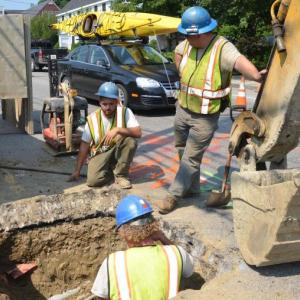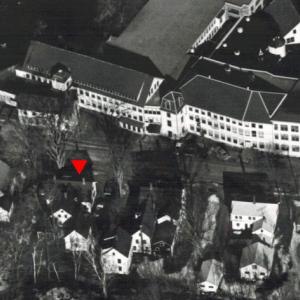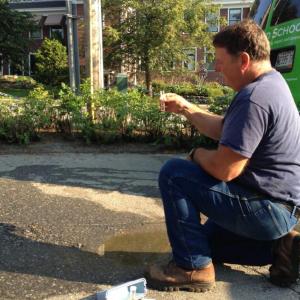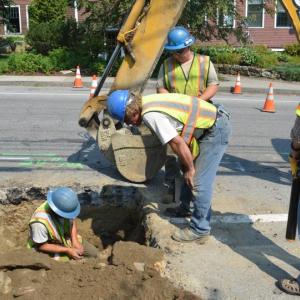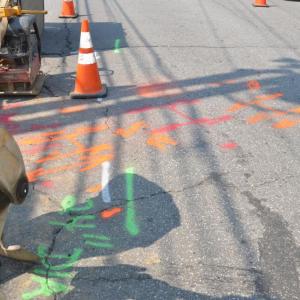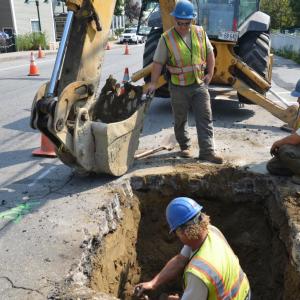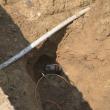Tending to Camden’s aging subterranean waterworks
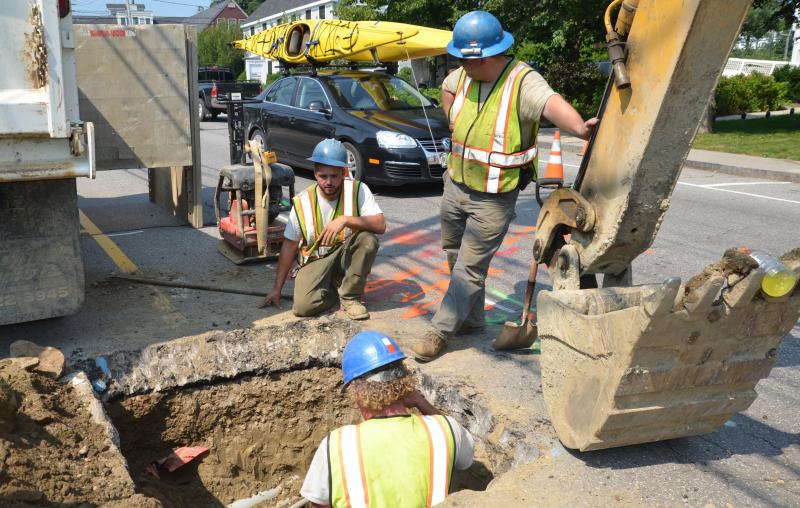 For a while, it was a real puzzle, trying to locate the pipe that led on the Mechanic Street water main. It took a few days of digging and sleuthing, and then it was shovel on metal, approximately four feet down beneath layers of tarmac, rocks and dirt. Eric Kenefick, Shaun McNulty and Lee Philbrook find the pipe using a resonator, computer coordinates and muscle power. (Photo by Lynda Clancy)
For a while, it was a real puzzle, trying to locate the pipe that led on the Mechanic Street water main. It took a few days of digging and sleuthing, and then it was shovel on metal, approximately four feet down beneath layers of tarmac, rocks and dirt. Eric Kenefick, Shaun McNulty and Lee Philbrook find the pipe using a resonator, computer coordinates and muscle power. (Photo by Lynda Clancy)
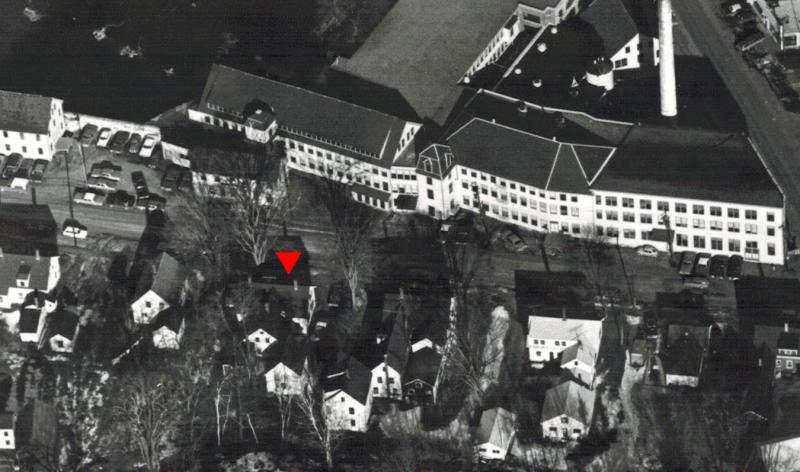 The Knox Mill and homes across the street, an aerial photo, circa 1963.
The Knox Mill and homes across the street, an aerial photo, circa 1963.
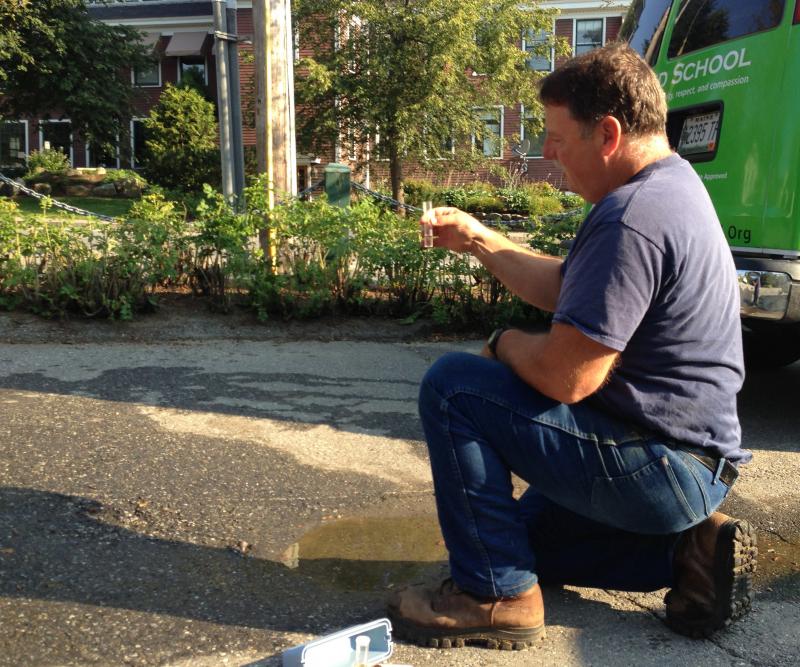 Hank Merchant, who works for Maine Water, arrived to test the water in the puddle. If it turns pink, it contains chlorine, indicating its source is the Maine Water main. (Photo by Lynda Clancy)
Hank Merchant, who works for Maine Water, arrived to test the water in the puddle. If it turns pink, it contains chlorine, indicating its source is the Maine Water main. (Photo by Lynda Clancy)
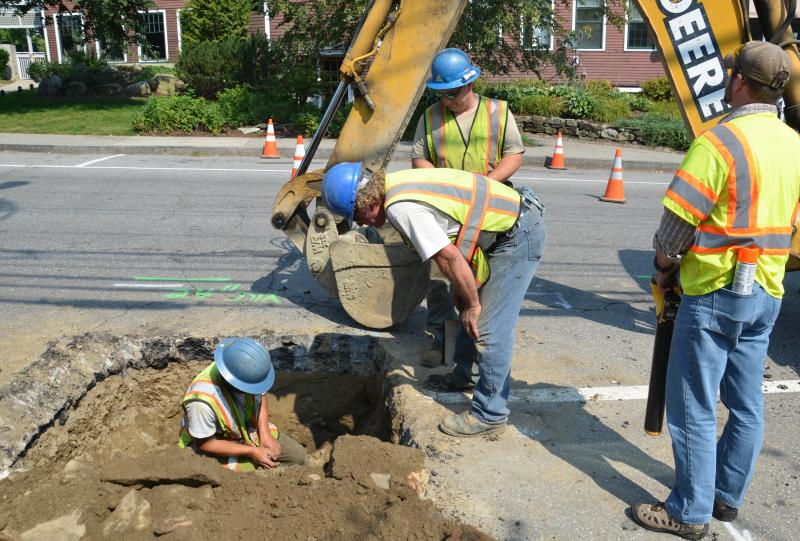 Eric Kenefick,Shaun McNulty, Lee Philbrook, all Maine Water employees, along with Matt Jandreau, of On Target, a contractor for Dig Safe. (Photo by Lynda Clancy)
Eric Kenefick,Shaun McNulty, Lee Philbrook, all Maine Water employees, along with Matt Jandreau, of On Target, a contractor for Dig Safe. (Photo by Lynda Clancy)
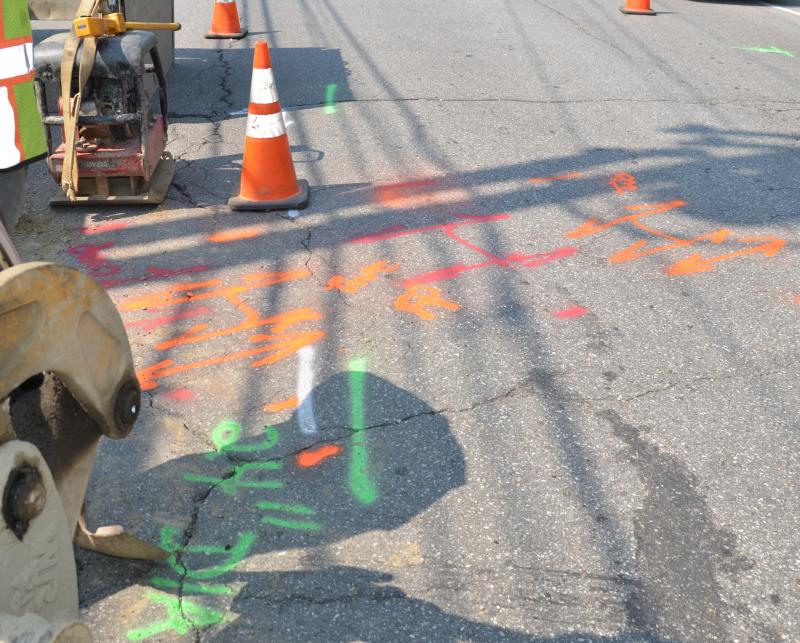 Ever wonder whose colors belongs to whom? Orange is communication, alarm, or signal lines; red is electric power lines (Central Maine Power); green is sewer and drain lines
Ever wonder whose colors belongs to whom? Orange is communication, alarm, or signal lines; red is electric power lines (Central Maine Power); green is sewer and drain lines
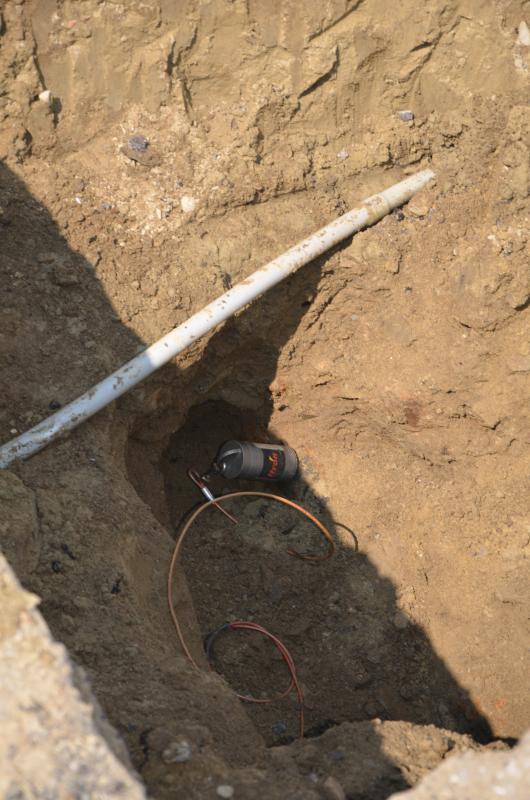 A magnetic resonator differentiates the pulsations of water, between a washing machine and a water meter, helping to locate the intermittent sounds of a pipe leak. (Photo by Lynda Clancy)
A magnetic resonator differentiates the pulsations of water, between a washing machine and a water meter, helping to locate the intermittent sounds of a pipe leak. (Photo by Lynda Clancy)
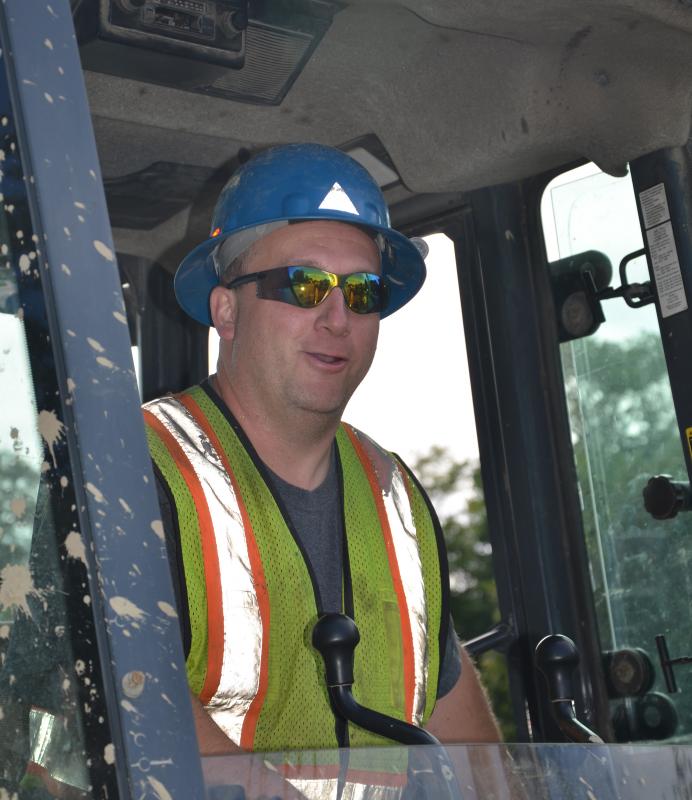 All in a day’s work for Lee Philbrook. (Photo by Lynda Clancy)
All in a day’s work for Lee Philbrook. (Photo by Lynda Clancy)
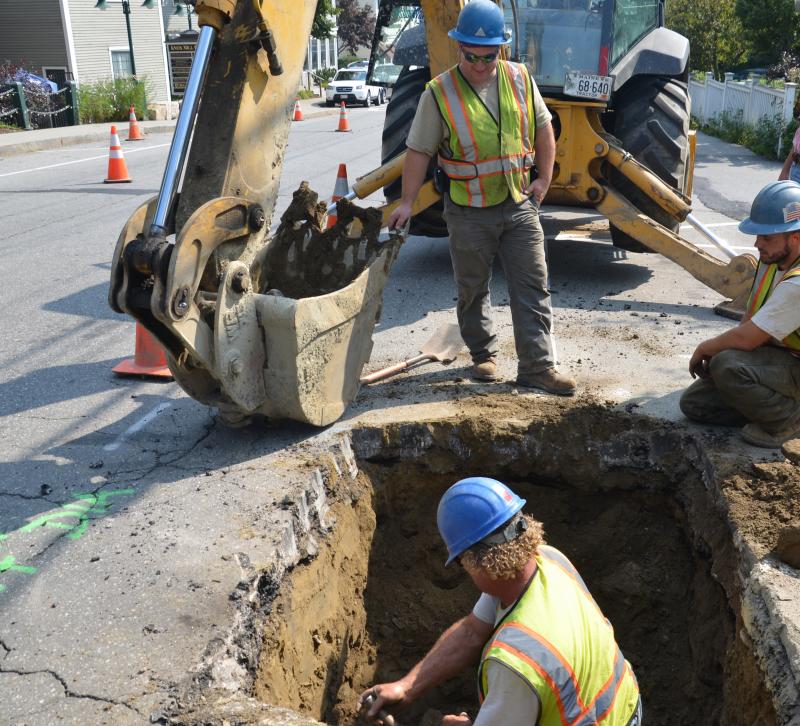
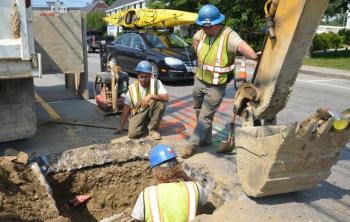 For a while, it was a real puzzle, trying to locate the pipe that led on the Mechanic Street water main. It took a few days of digging and sleuthing, and then it was shovel on metal, approximately four feet down beneath layers of tarmac, rocks and dirt. Eric Kenefick, Shaun McNulty and Lee Philbrook find the pipe using a resonator, computer coordinates and muscle power. (Photo by Lynda Clancy)
For a while, it was a real puzzle, trying to locate the pipe that led on the Mechanic Street water main. It took a few days of digging and sleuthing, and then it was shovel on metal, approximately four feet down beneath layers of tarmac, rocks and dirt. Eric Kenefick, Shaun McNulty and Lee Philbrook find the pipe using a resonator, computer coordinates and muscle power. (Photo by Lynda Clancy)
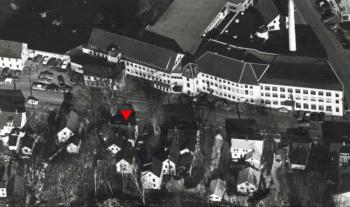 The Knox Mill and homes across the street, an aerial photo, circa 1963.
The Knox Mill and homes across the street, an aerial photo, circa 1963.
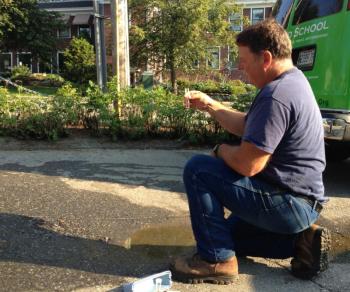 Hank Merchant, who works for Maine Water, arrived to test the water in the puddle. If it turns pink, it contains chlorine, indicating its source is the Maine Water main. (Photo by Lynda Clancy)
Hank Merchant, who works for Maine Water, arrived to test the water in the puddle. If it turns pink, it contains chlorine, indicating its source is the Maine Water main. (Photo by Lynda Clancy)
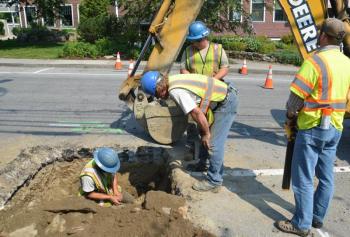 Eric Kenefick,Shaun McNulty, Lee Philbrook, all Maine Water employees, along with Matt Jandreau, of On Target, a contractor for Dig Safe. (Photo by Lynda Clancy)
Eric Kenefick,Shaun McNulty, Lee Philbrook, all Maine Water employees, along with Matt Jandreau, of On Target, a contractor for Dig Safe. (Photo by Lynda Clancy)
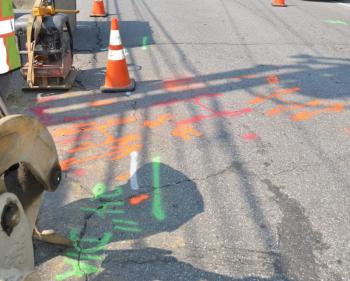 Ever wonder whose colors belongs to whom? Orange is communication, alarm, or signal lines; red is electric power lines (Central Maine Power); green is sewer and drain lines
Ever wonder whose colors belongs to whom? Orange is communication, alarm, or signal lines; red is electric power lines (Central Maine Power); green is sewer and drain lines
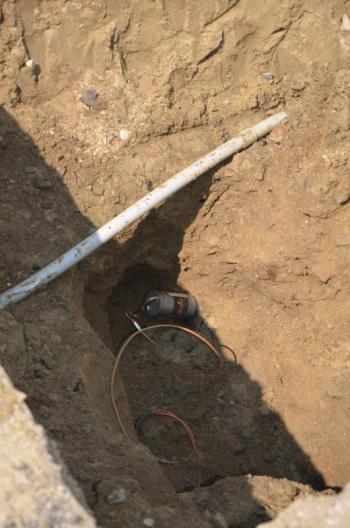 A magnetic resonator differentiates the pulsations of water, between a washing machine and a water meter, helping to locate the intermittent sounds of a pipe leak. (Photo by Lynda Clancy)
A magnetic resonator differentiates the pulsations of water, between a washing machine and a water meter, helping to locate the intermittent sounds of a pipe leak. (Photo by Lynda Clancy)
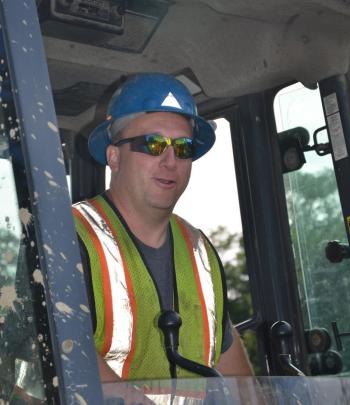 All in a day’s work for Lee Philbrook. (Photo by Lynda Clancy)
All in a day’s work for Lee Philbrook. (Photo by Lynda Clancy)
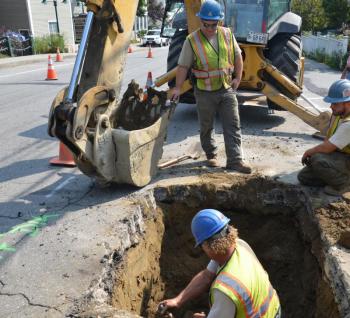
CAMDEN — A slowly growing puddle of water on a Mechanic Street parking lot was barely noticeable for weeks, if not months. In a climate where it rains a lot, it was unremarkable, even as it sent a permanent wet stain beneath the daily parked cars and into nearby rugosa. But under the hot August sun, as the puddle failed to evaporate, its origin became a curiosity. Press a sandal down onto the pavement, and the water bubbled up through hairline cracks. Was it water? Was it from a spring? Was it sewage?
“Once in a blue moon, this happens,” said Shaun McNulty, an employee of Maine Water, the public utility that delivers water along 250 miles of pipes through Camden, Owls Head, Rockport, Rockland, Thomaston, Union and parts of Warren. He spoke from the bottom of a five-foot hole on the side of Mechanic Street, across the road from the Knox Mill, gazing an underground repair he, and two colleagues, spent the last three days trying to resolve.
The puddle had been produced by an old leaking water valve that once served a large farmhouse at 34 Mechanic Street, a valve turned off probably in the early 1980s or late 1970s, when a neighborhood of homes (see aerial photo) across from the Knox Woolen Mill was apparently torn down, their foundations and infrastructure paved over for a parking lot that still serves workers and visitors to the mill. But the valve was never disconnected from the nearby water main that runs down Mechanic Street, and by 2013, the old system demanded attention.
McNulty lifted a wrench toward a valve at the intersection of two pipes, one being a large iron water main, six inches in diameter, which was laid down the length of Mechanic Street in 1883 (Two such sister water mains of the same vintage extend down Route 1 and Russell Avenue in Rockport to Chestnut Street in Camden). Extending perpendicular to McNulty’s water main was a smaller copper pipe, installed in 1963, itself a replacement for an original 1938 water feed that once served the 34 Mechanic Street home.
McNulty, along with Main Water’s Eric Kenefick and Lee Philbrook, had spent two days hunting down the source of the leak. After the puddle’s existence was first reported, Maine Water employee Hank Merchant arrived at the parking lot early in the morning, scooped up a sample of the puddle water, mixed it with the chemical DPD, and determined by its immediate light rose blush that it contained chlorine. That verified that the puddle water was a product of the Maine Water system, and not a leak from a nearby home, or an unpleasant product of the town’s sewer system.
A water company service record card from 1938 confirmed that a feed from the Mechanic Street water main had been installed in 1938 to Ida Ingraham’s house at 34 Mechanic Street. Other names on the rate card included Alma Meynell and Edgar Reynolds, before MBNA bought the mill complex in 1994 and the parking lot across the street. The card also contained a concise sketch of the pipes, drawn efficiently early on the water company’s history.
Under a hot August sun and 75 years later, workers for the same water company, albeit many corporate iterations later, began excavating the system. They pounded the pavement with a jackhammer, scooped away eight inches of layered tarmac and then dirt, and then they took turns climbing deeper into the hole with a shovel, first to hunt for the water main, and then the old house feed. As the morning rolled into afternoon, another Maine Water worker appeared with a ladder, placing it beside the trench. Periodically, McNulty would shoulder a large rock up over the side.
It was not initially gratifying work, as both the main and the side feed were covered in decades of earth. The power line had been located by a Matt Jandreau, from On Target, the Gardiner-based subcontractor of Dig Safe. That nonprofit provides a free service that is funded by member power companies, and which maintains a database of power line locations using latitude and longitude, as well as street maps. Before digging — for public, business or residential projects — it is mandatory that Dig Safe be notified in order to identify the power lines. The goal is to avoid accidents, and power disruptions to communities.
The utility line, carrying phone and cable, has also been found, and it was clear digging now, though it would take hours.
Maine Water has a long history in the Midcoast. It was originally organized in 1885 as the Camden and Rockland Water Company, and in 1895 it acquired the Rockland Water Company, which had been incorporated in 1850 to serve Rockland village. In 1959, Consumers Water Company, of Portland, acquired the water company. More than a century later, the Philadelphia Suburban Corp. bought the company. That became Aqua America, the nation’s largest investor-owned water utility, and was at one point a subsidiary of the French company Vivendi. In 2011, Aqua America divested of Aqua Maine, and now it is owned by the Connecticut Water Services.
Eventually, the shovel dinged and the main was located. But the smaller cross pipe to 34 Mechanic Street was a much harder encounter. Philbrook set a magnetic signal locator into the expanding hole. The resonator picks up and distinguishes the different sounds of water uses, of the straight whoosh of water down the main from the pulsation of a demanding washing machine to the steady monitoring of water meters mounted on the sides of homes. Hopefully, it would also detect the sound of a leak off of the water main.
After 15 minutes of recording, McNulty took the resonator back to his truck, hooked it with his computer, and using mapping coordinates, verified that the leak was several feet from where they were digging. By then, it was late in the day, so the Maine Water crew parked the backhoe over the hole, and went home. By 8 a.m. Friday morning, they were again at it. This time, they hit paydirt. The copper pipe and the connecting valve emerged from beneath a layer of dirt, further down the street.
With one turn of the wrench, McNulty shut off the valve, sealing off the water feed to the old leaking valve that sat below the parking lot. For good measure, he took a saw and cut the copper pipe completely from the water main. And at the same time, he shoveled dirt into the old sewer line that also ran toward 34 Mechanic Street, “plugging it up,” he said.
To Maine Water, these periodic fixes of underground breaks and leaks come with the territory of maintaining waterworks that are now 130 years old, if not older in some areas. It is part of America’s collective aging infrastructure — well engineered but built with materials that corrode and disintegrate.
“For the last 20 years, we have concentrated on changes to the treatment and quality of water,” said Rick Knowlton, vice president at the Rockport office of Maine Water. “The next 20 years, we will need to focus on the quality of piping, the infrastructure. We all have the same foundation to work with and this is the challenge of the next generation of water utility managers.”
It is expensive, he said. Where the original cast iron main that runs down the hills from Mirror Lake, Rockport, toward downtown Camden once cost approximately $1 to $2 a foot, its replacement, with ductile iron, will cost $120 to $150 per foot. Add the cost of digging and repaving after replacing a water main, and the average cost for such a project in New England is almost $1 million per mile, he said.
With 250 miles of pipes in Camden, Rockland, Thomaston and Warren, that becomes “a big number,” he said.
In the meantime, if an unrelenting puddle grows beneath a downtown parking lot, or street, you know who to call: your municipal public works or Maine Water.
Editorial Director Lynda Clancy can be reached at lyndaclancy@penbaypilot.com; 706-6657.
Event Date
Address
United States

